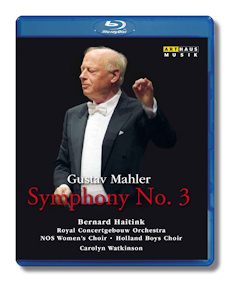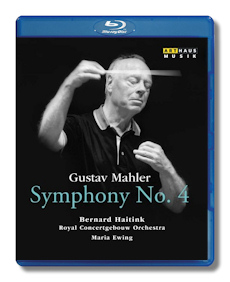
The Internet's Premier Classical Music Source
Related Links
- Mahler Reviews
- Latest Reviews
- More Reviews
-
By Composer
-
Collections
DVD & Blu-ray
Books
Concert Reviews
Articles/Interviews
Software
Audio
Search Amazon
Recommended Links
Site News
 Blu-ray Review
Blu-ray Review
Gustav Mahler

Symphony #3
Carolyn Watkinson, alto
NOS Women's Choir & Holland Boys Choir
Concertgebouw Orchestra/Bernard Haitink
Arthaus Musik Blu-ray 109120 Full Screen LPCM Stereo
Also available on DVD 109119:
Amazon
- UK
- Germany
- Canada
- France
- Japan
- ArkivMusic
- CD Universe
- JPC


Symphony #4
Maria Ewing, soprano
Concertgebouw Orchestra/Bernard Haitink
Arthaus Musik Blu-ray 109109 Full Screen LPCM Stereo
Also available on DVD 109108:
Amazon
- UK
- Germany
- Canada
- France
- Japan
- ArkivMusic
- CD Universe
- JPC
This summer Arthaus Musik released two 1980's television recordings from Amsterdam with Bernard Haitink conducting the Concertgebouw Orchestra (the orchestra had not yet received the honorific "Royal" at the time of these performances). The recording of the Third (from 1983) is an outstanding performance and a very welcome addition to the Mahler discography. The Fourth, recorded in 1986, is very competent, but less distinguished.
As a Mahler conductor Haitink is lucid rather than extrovert. His strengths are attention to clarity of overall form and orchestral texture. These strengths emerge to very good effect in the Third, which is a difficult symphony to bring off well. The first movement is particularly successful. It is easy to get lost in, because it has so many lines of musical argument both unfolding in parallel and interrupting each other, but Haitink brings the unity of the movement out very clearly. He is helped by some very fine playing by the soloists. The second movement minuet has a nice, dancing lilt to it and the clarity of Haitink's conducting comes across very clearly in the Scherzo – with more fine playing by the soloists, including the off-stage post horn. I found Carolyn Watkinson's alto well matched for the fourth movement, and she does not attempt to pronounce as she were Erda. – which is fortunate, since Nietzsche's verses are quite portentous enough without that. The control of the performance continues into the fifth movement, which strikes a satisfying balance between the soloist, the two choirs, and the orchestra. The finale is quite simply magnificent and the audience responds with a well-deserved standing ovation for the massed forces on stage.
There is nothing particularly wrong with the performance of the Fourth, but this is not a symphony that benefits as dramatically from Haitink's command of structure in the way that the Third does. Whereas in the earlier symphony Haitink brings clarity and discipline to what can easily seem unruly and self-indulgent, what comes across here is a perhaps excessive sense of restraint. The opening dialog between strong and woodwind emerges with the clarity and focus that one would expect and the Trio and the Adagio are ravishingly played. But the three purely orchestral movements all lack a certain edge. The Scherzo is not really ghoulish enough to convey death playing the fiddle. Maria Ewing has a lovely tone in the final movement, although she indulged in some overly operatic moments that jarred a little to my ear.
Both discs have one alarming videographical quirk. A huge image of Haitink's upper half occasionally dominates the picture, with the orchestra and conductor in soft focus in the background. I found this rather disorienting. Other than that, though, the filming does a very good job of following the orchestral line. I was not impressed with the production values. The two discs have only the most rudimentary menus and the program booklets are very sketchy with no indication of performance dates, or any other background information.
The Fourth will probably only appeal to Haitink aficionados. I highly recommend the Third, however.
Copyright © 2015, José Luis Bermúdez





















